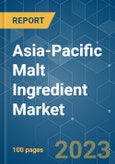Malt has been a primary ingredient for applications in the brewing industry for decades. With the growing awareness about its benefits, malt has tapped into the food industry as an additive, flavor, colorant, and ingredient. Moreover, the high consumption of this ingredient in the feed industry is further aiding the market studied. Barley remains the most preferred source of malt for application in the beverage industry, owing to its unique enzyme property and relatively better taste profiles.
Moreover, natural substances are increasingly in demand for usage in a variety of dermatological and cosmetic applications. To fulfill the naturalness of components, these elements frequently act as substitutes for dangerous synthetic raw materials or non-sustainable generated raw materials. To increase bioactivity in cosmetic applications, malt, one of the most significant ingredients in the brewing business, comprises a variety of substances, including phenolic compounds and melanoidins. In addition, malt includes smaller phenolic compounds with strong antioxidant effects, including procyanidins, lignans, alkylphenols, and derivatives of the cinnamic acid.
Furthermore, many baked foods contain malt powder or malt flour, which adds a natural sweetness to the baked products and imparts a brighter and browner result. There are two varieties of malt powder. Diastatic malt contains enzymes that break down starches into sugar and typically produce sweeter, smoother, and higher-rising baked items. Non-diastatic malt is considerably more typical but lacks enzymes. This can nonetheless provide baked items with a desirable flavor and appearance.
APAC Malt Ingredient Market Trends
Growing Popularity of Craft Beer
The demand for the craft brewing and distilling industries has experienced significant growth during the past few years. Consumers across Asia-Pacific have been seeking distinctive and flavorful beer, which has been pushing the market for malt ingredients in the beer market space. Moreover, the increasing development of microbreweries and the growing production of craft beer have led to a growing demand for specialty malts. For instance, according to World Bank data, in China, 1.4 billion people consume beer every year. According to an Australian craft beer survey, in 2020, the highest share of Australian craft beer drinkers was aged between 30 and 39, at around 40%. The statistics also show that soon, craft brewers are expected to consume most of the malt used by the brewing industry within the next five years, thereby driving the market growth of malt ingredients.Also, the leading malt manufacturers have been providing a wide range of malt varieties suiting various requirements of craft breweries. For instance, Cargill Inc. offers a range of craft malts, including base malts, kilned caramel malts, and roasted malts, in varying color and flavor profiles.
Thus, craft malting has been popular in the marketplace as microbreweries search for unique, consumer-capturing brews that no other breweries can offer.
The Indian Malt Market is Likely to Foster the Growth of the Asia-Pacific Malt Ingredient Market
The end users of malt and malt extracts are the breweries (for beer production), distilleries (for the manufacture of premium quality whisky), food (for malted milk foods, bakery, biscuits, confectionery, chocolate powder, cornflakes, imitation coffee, baby food, etc.), pharmaceuticals (for tonics, health foods, and slim diets), and other end users (such as pet foods and medium for bacteria cultivation). In India, the growth in the rate of consumption of processed and convenience food products has contributed significantly to the sales of malt ingredients. The increased importance of malt extracts as functional ingredients in the formulation of confectionary and nutritional drinks on account of their vitamin B, essential amino acid, and fiber content is driving the demand for malt ingredients in the country.Barley, having the major share among the malt ingredients, has its production confined to the northern states of India. However, the unavailability of quality malt increases the import of malt extracts from other countries to India. Thus, India is looking to import one million tonnes of Australian barley every year, as per Grain producer Australia (GPA), which is expected to meet the rising demand and result in an alcohol price drop in the country. Beer, whiskey, and flavored alcoholic beverages benefit from the trade deal as the reduction in production cost would ultimately increase the revenue.
Furthermore, leading companies are involved in the extensive research and development of different innovative products and revamping their old offerings with new ingredients. For instance, Heinz Power Sprouts, which supplemented Complan in the malt food segment, initially used barley malt and is now including ragi in its malt drinks. Also, Coca-Cola offers a non-alcoholic malt drink under the brand name ‘Barbican’.
Competitive Landscape
The Asia-Pacific malt ingredients market is fragmented due to various global players in the region providing solutions for multiple applications. The privately labeled players are also increasing as the small-scale industries source their malt ingredients from more prominent players in the market. The lower requirement of small-scale industries is also a reason for promoting private players in the Asia-Pacific countries. The manufacturers of malt ingredients are aiming at developing versatile products derived from malt from various sources to utilize them in as many applications as they can. The major players in the market are indulging in market expansion techniques and product innovations to strengthen their market position.Additional benefits of purchasing the report:
- The market estimate (ME) sheet in Excel format
- 3 months of analyst support
This product will be delivered within 2 business days.
Table of Contents
Companies Mentioned (Partial List)
A selection of companies mentioned in this report includes, but is not limited to:
- VIVESCIA Group
- Axereal
- Muntons PLC
- Puremalt Products Ltd
- GrainCorp Group
- Barrett Burston Malting
- Rahr Corporation
Methodology

LOADING...










